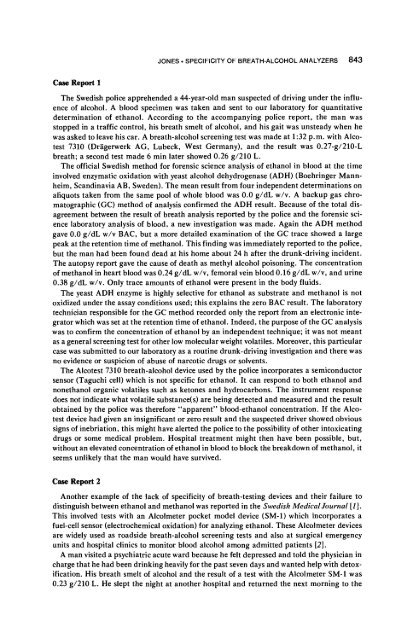Observations on the Specificity of Breath-Alcohol Analyzers ... - Library
Observations on the Specificity of Breath-Alcohol Analyzers ... - Library
Observations on the Specificity of Breath-Alcohol Analyzers ... - Library
You also want an ePaper? Increase the reach of your titles
YUMPU automatically turns print PDFs into web optimized ePapers that Google loves.
Case Report 1<br />
JONES 9 SPECIFICITY OF BREATH-ALCOHOL ANALYZERS 843<br />
The Swedish police apprehended a 44-year-old man suspected <strong>of</strong> driving under <strong>the</strong> influ-<br />
ence <strong>of</strong> alcohol. A blood specimen was taken and sent to our laboratory for quantitative<br />
determinati<strong>on</strong> <strong>of</strong> ethanol. According to <strong>the</strong> accompanying police report, <strong>the</strong> man was<br />
stopped in a traffic c<strong>on</strong>trol, his breath smelt <strong>of</strong> alcohol, and his gait was unsteady when he<br />
was asked to leave his car. A breath-alcohol screening test was made at 1:32 p.m. with Alco-<br />
test 7310 (Dr~igerwerk AG, Lubeck, West Germany), and <strong>the</strong> result was 0.27-g/210-L<br />
breath; a sec<strong>on</strong>d test made 6 min later showed 0.26 g/210 L.<br />
The <strong>of</strong>ficial Swedish method for forensic science analysis <strong>of</strong> ethanol in blood at <strong>the</strong> time<br />
involved enzymatic oxidati<strong>on</strong> with yeast alcohol dehydrogenase (ADH) (Boehringer Mann-<br />
helm, Scandinavia AB, Sweden). The mean result from four independent determinati<strong>on</strong>s <strong>on</strong><br />
aliquots taken from <strong>the</strong> same pool <strong>of</strong> whole blood was 0.0 g/dL w/v. A backup gas chro-<br />
matographic (GC) method <strong>of</strong> analysis c<strong>on</strong>firmed <strong>the</strong> ADH result. Because <strong>of</strong> <strong>the</strong> total dis-<br />
agreement between <strong>the</strong> result <strong>of</strong> breath analysis reported by <strong>the</strong> police and <strong>the</strong> forensic sci-<br />
ence laboratory analysis <strong>of</strong> blood, a new investigati<strong>on</strong> was made. Again <strong>the</strong> ADH method<br />
gave 0.0 g/dL w/v BAC, but a more detailed examinati<strong>on</strong> <strong>of</strong> <strong>the</strong> GC trace showed a large<br />
peak at <strong>the</strong> retenti<strong>on</strong> time <strong>of</strong> methanol. This finding was immediately reported to <strong>the</strong> police,<br />
but <strong>the</strong> man had been found dead at his home about 24 h after <strong>the</strong> drunk-driving incident.<br />
The autopsy report gave <strong>the</strong> cause <strong>of</strong> death as methyl alcohol pois<strong>on</strong>ing. The c<strong>on</strong>centrati<strong>on</strong><br />
<strong>of</strong> methanol in heart blood was 0.24 g/alL w/v, femoral vein blood 0.16 g/dL w/v, and urine<br />
0.38 g/dL w/v. Only trace amounts <strong>of</strong> ethanol were present in <strong>the</strong> body fluids.<br />
The yeast ADH enzyme is highly selective for ethanol as substrate and methanol is not<br />
oxidized under <strong>the</strong> assay c<strong>on</strong>diti<strong>on</strong>s used; this explains <strong>the</strong> zero BAC result. The laboratory<br />
technician resp<strong>on</strong>sible for <strong>the</strong> GC method recorded <strong>on</strong>ly <strong>the</strong> report from an electr<strong>on</strong>ic inte-<br />
grator which was set at <strong>the</strong> retenti<strong>on</strong> time <strong>of</strong> ethanol. Indeed, <strong>the</strong> purpose <strong>of</strong> <strong>the</strong> GC analysis<br />
was to c<strong>on</strong>firm <strong>the</strong> c<strong>on</strong>centrati<strong>on</strong> <strong>of</strong> ethanol by an independent technique; it was not meant<br />
as a general screening test for o<strong>the</strong>r low molecular weight volatiles. Moreover, this particular<br />
case was submitted to our laboratory as a routine drunk-driving investigati<strong>on</strong> and <strong>the</strong>re was<br />
no evidence or suspici<strong>on</strong> <strong>of</strong> abuse <strong>of</strong> narcotic drugs or solvents.<br />
The AIcotest 7310 breath-alcohol device used by <strong>the</strong> police incorporates a semic<strong>on</strong>ductor<br />
sensor (Taguchi cell) which is not specific for ethanol. It can resp<strong>on</strong>d to both ethanol and<br />
n<strong>on</strong>ethanol organic volatiles such as ket<strong>on</strong>es and hydrocarb<strong>on</strong>s. The instrument resp<strong>on</strong>se<br />
does not indicate what volatile substance(s) are being detected and measured and <strong>the</strong> result<br />
obtained by <strong>the</strong> police was <strong>the</strong>refore "apparent" blood-ethanol c<strong>on</strong>centrati<strong>on</strong>. If <strong>the</strong> AIco-<br />
test device had given an insignificant or zero result and <strong>the</strong> suspected driver showed obvious<br />
signs <strong>of</strong> inebriati<strong>on</strong>, this might have alerted <strong>the</strong> police to <strong>the</strong> possibility <strong>of</strong> o<strong>the</strong>r intoxicating<br />
drugs or some medical problem. Hospital treatment might <strong>the</strong>n have been possible, but,<br />
without an elevated c<strong>on</strong>centrati<strong>on</strong> <strong>of</strong> ethanol in blood to block <strong>the</strong> breakdown <strong>of</strong> methanol, it<br />
seems unlikely that <strong>the</strong> man would have survived.<br />
Case Report 2<br />
Ano<strong>the</strong>r example <strong>of</strong> <strong>the</strong> lack <strong>of</strong> specificity <strong>of</strong> breath-testing devices and <strong>the</strong>ir failure to<br />
distinguish between ethanol and methanol was reported in <strong>the</strong> Swedish Medical Journal [1].<br />
This involved tests with an Alcolmeter pocket model device (SM-1) which incorporates a<br />
fuel-cell sensor (electrochemical oxidati<strong>on</strong>) for analyzing ethanol. These Alcolmeter devices<br />
are widely used as roadside breath-alcohol screening tests and also at surgical emergency<br />
units and hospital clinics to m<strong>on</strong>itor blood alcohol am<strong>on</strong>g admitted patients [2].<br />
A man visited a psychiatric acute ward because he felt depressed and told <strong>the</strong> physician in<br />
charge that he had been drinking heavily for <strong>the</strong> past seven days and wanted help with detox-<br />
ificati<strong>on</strong>. His breath smelt <strong>of</strong> alcohol and <strong>the</strong> result <strong>of</strong> a test with <strong>the</strong> AIcolmeter SM-1 was<br />
0.23 g/210 L. He slept <strong>the</strong> night at ano<strong>the</strong>r hospital and returned <strong>the</strong> next morning to <strong>the</strong>

















